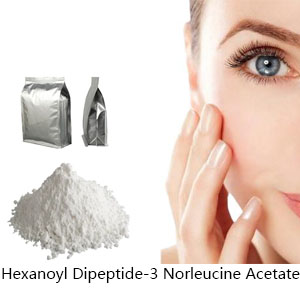Hexanoyl Dipeptide-3 Norleucine Acetate:Advanced anti-aging skincare innovation

Hexanoyl Dipeptide-3 Norleucine Acetate is a synthetic peptide widely used in cosmetic formulations for its exfoliating and anti-aging benefits. Unlike traditional exfoliants, which rely on abrasive particles or acids, this peptide works through biomimetic signaling to stimulate skin renewal in a gentler and more targeted manner. Its innovative mechanism, combined with compatibility across various skin types, makes it a valuable active ingredient in advanced skincare products.
Understanding the Peptide Structure
This ingredient is a dipeptide, meaning it contains two amino acids—one of which is norleucine, a non-proteinogenic analog. The compound is acylated with a hexanoyl group, giving it lipophilic properties that enhance skin penetration. The acetate salt form stabilizes the molecule and improves solubility in formulations.
Peptide Signaling and Skin Renewal
The peptide mimics natural biological signals, particularly those involved in skin desquamation. By stimulating protease activity in the upper layers of the epidermis, it promotes the shedding of dead skin cells, thereby accelerating cell turnover. This approach avoids inflammation and over-exfoliation, which are common with conventional methods.
Stability and Compatibility
Hexanoyl Dipeptide-3 Norleucine Acetate remains stable in a wide pH range (typically 4.0 to 7.5) and is compatible with various formulation types, including gels, creams, and serums. It is also non-photosensitizing, allowing use in day and night products without added risk under sunlight.
Mechanism of Action
The primary mode of action centers on enhancing natural exfoliation and encouraging epidermal turnover. Unlike alpha-hydroxy acids (AHAs) or beta-hydroxy acids (BHAs), this peptide does not chemically dissolve intercellular bonds but rather biologically encourages the process through signal mimicking.
Protease Activation
The peptide activates kallikrein-related peptidases (KLKs), which are key enzymes in the process of desquamation. This enhances the natural exfoliation cycle, improving skin texture and radiance while minimizing irritation.
Barrier Function Preservation
Due to its biomimetic nature, the peptide supports the skin’s barrier integrity. It avoids the disruption that acids can cause, making it a preferred option for sensitive or compromised skin types.
Clinical Applications in Skincare
Hexanoyl Dipeptide-3 Norleucine Acetate is featured in a variety of dermocosmetic products focused on anti-aging, brightening, and resurfacing. Its non-aggressive nature allows frequent use without cumulative irritation.
Wrinkle Reduction and Skin Smoothness
Regular use leads to a visibly smoother skin surface. Clinical studies show a reduction in fine lines and increased skin luminosity after several weeks of consistent application, particularly when paired with moisturizing and antioxidant ingredients.
Hyperpigmentation Management
By enhancing turnover, the peptide aids in the gradual fading of dark spots and uneven skin tone. It can be used alongside ingredients like niacinamide or vitamin C for compounded effects without irritation risks.
Formulation Guidance and Use
When formulating with this peptide, formulators often include it at concentrations ranging from 0.5% to 2.0%. It works well with soothing agents like panthenol, ceramides, and hyaluronic acid for balanced, multi-functional skincare products.
Ideal Product Formats
Water-based serums and emulsion creams are typical carriers. The peptide can be included in both rinse-off and leave-on products. Encapsulation technologies such as liposomes or nanoemulsions may be used to further enhance delivery.
Application Frequency and Tips
Recommended use is once or twice daily after cleansing and before heavier moisturizers. Users should apply sunscreen when using any exfoliating ingredient, although this peptide itself does not increase sun sensitivity directly.
Market Potential and Innovation
The cosmetic industry continues to invest in bioactive peptides like Hexanoyl Dipeptide-3 Norleucine Acetate as consumer demand shifts toward effective yet gentle products. It represents a bridge between performance and tolerance, addressing the growing need for inclusive skincare solutions.
Trends in Biomimetic Ingredients
This peptide fits within a broader trend of biomimetic innovation. As skincare becomes more personalized and science-driven, ingredients that mimic natural biological processes offer promising routes to achieve results without compromising skin health.
Regulatory and Safety Status
It is generally recognized as safe for cosmetic use in Europe, North America, and Asia. Patch testing and irritation studies report a low incidence of adverse reactions, even on sensitive skin, making it a dependable choice for modern cosmetic formulations.


